seats MERCEDES-BENZ SLC ROADSTER 2018 Owner's Manual
[x] Cancel search | Manufacturer: MERCEDES-BENZ, Model Year: 2018, Model line: SLC ROADSTER, Model: MERCEDES-BENZ SLC ROADSTER 2018Pages: 298, PDF Size: 5.26 MB
Page 4 of 298
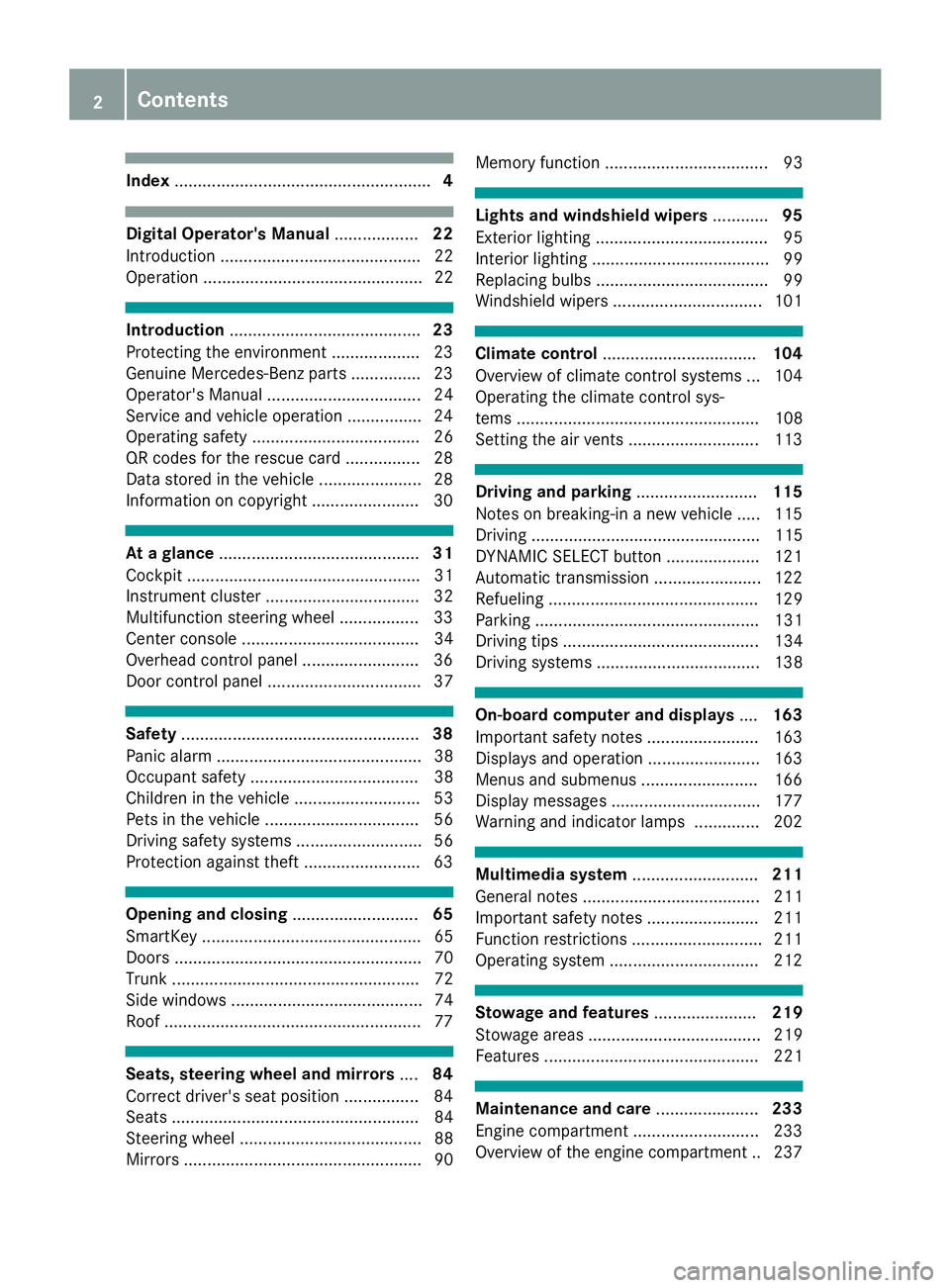
Index....................................................... 4
Digital Operator's Manual..................22
Introductio n........................................... 22
Operation ............................................... 22
Introduction ......................................... 23
Protecting the environment ...................2 3
Genuine Mercedes-Ben zparts............... 23
Operator's Manual ................................. 24
Service and vehicle operation ................2 4
Operating safety .................................... 26
QR codes for the rescue card ................2 8
Data stored in the vehicl e...................... 28
Informatio noncopyright ....................... 30
Atag lance ........................................... 31
Cockpi t.................................................. 31
Instrument cluster. ................................ 32
Multifunctio nsteering whee l................. 33
Center consol e...................................... 34
Overhead contro lpan el .........................3 6
Doorc ontrolpan el ................................. 37
Safety ................................................... 38
Panic alar m............................................ 38
Occupant safety .................................... 38
Childre ninthe vehicl e........................... 53
Pets in the vehicl e................................. 56
Driving safety systems ........................... 56
Protection against theft .........................6 3
Opening and closing...........................65
SmartKey ............................................... 65
Doors ..................................................... 70
Trunk ..................................................... 72
Side windows ......................................... 74
Roof .......................................................7 7
Seats, steering wheel and mirrors....84
Correct driver's seat position ................8 4
Seats ..................................................... 84
Steering wheel ....................................... 88
Mirrors. .................................................. 90 Memory function ................................... 93
Lights and windshield wipers
............95
Exterior lighting ..................................... 95
Interior lighting ...................................... 99
Replacing bulb s..................................... 99
Windshield wipers ................................ 101
Climate control ................................. 104
Overview of climate control systems ... 104
Operating the climate control sys-
tems .................................................... 108
Setting the ai rvents ............................ 113
Drivin gand parking .......................... 115
Notesonb reaking-inanew vehicl e..... 115
Driving ................................................. 115
DYNAMIC SELECT button .................... 121
Automati ctransmissio n....................... 122
Refueling ............................................. 129
Parking ................................................ 131
Driving tip s.......................................... 134
Driving systems ................................... 138
On-board computer and displays ....163
Important safety notes ........................ 163
Displays and operation ........................ 163
Menusa nd submenus ......................... 166
Displa ymessages ................................ 177
Warning and indicator lamps .............. 202
Multimedi asystem ........................... 211
Generaln otes ...................................... 211
Important safety notes ........................ 211
Function restrictions ............................ 211
Operating system ................................ 212
Stowag eand features ...................... 219
Stowag eareas ..................................... 219
Feature s.............................................. 221
Maintenancea nd care...................... 233
Engine compartment ........................... 233
Overview of the engine compartment .. 237
2Contents
Page 18 of 298
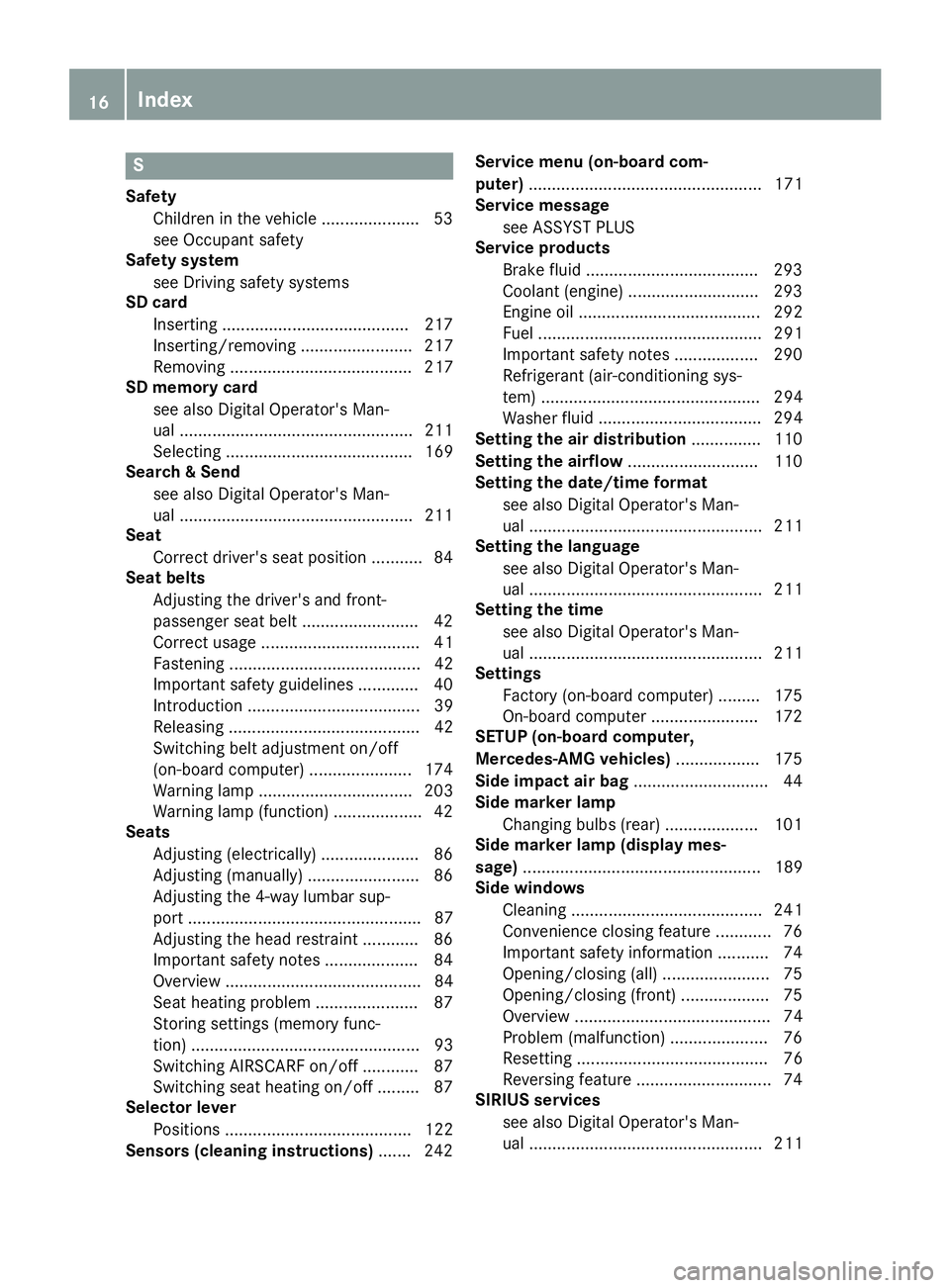
S
SafetyChildren in the vehicle ..................... 53
see Occupant safety
Safety system
see Driving safety systems
SD card
Inserting ........................................2 17
Inserting/removing ........................ 217
Removing ....................................... 217
SD memory card
see also Digita lOperator's Man-
ua l..................................................2 11
Selecting ........................................ 169
Search&S end
see also Digita lOperator's Man-
ua l..................................................2 11
Seat
Correct driver's seatp osition ........... 84
Seat belts
Adjusting the driver's and front-
passenger seatb elt......................... 42
Correct usag e.................................. 41
Fastening ......................................... 42
Important safety guideline s............. 40
Introduction ..................................... 39
Releasing ......................................... 42
Switching belt adjustment on/off
(on-board computer) ...................... 174
Warning lamp ................................. 203
Warning lamp (function) ................... 42
Seats
Adjusting (electrically) ..................... 86
Adjusting (manually) ........................ 86
Adjusting the 4-wa ylum bars up-
por t.................................................. 87
Adjusting the headr estraint ............ 86
Important safety notes .................... 84
Overview .......................................... 84
Seath eating problem ...................... 87
Storing settings (memory func-
tion) ................................................. 93
Switching AIRSCAR Fon/off. ........... 87
Switching seath eating on/off......... 87
Selecto rlever
Positions ........................................ 122
Sensors (cleaning instructions) ....... 242Servic
emenu( on-board com-
puter) .................................................. 171
Servic emessage
see ASSYST PLUS
Servic eproducts
Brake fluid ..................................... 293
Coolant (engine) ............................ 293
Engine oil. ...................................... 292
Fue l................................................ 291
Important safety notes .................. 290
Refrigerant (air-conditioning sys-
tem) ............................................... 294
Washerf lui
d ................................... 294
Settingt he air distribution ............... 110
Setting the airflow ............................ 110
Setting the date/time format
see also Digital Operator's Man-
ual.................................................. 211
Setting the language
see also Digital Operator's Man-
ual.................................................. 211
Setting the time
see also Digital Operator's Man-
ual.................................................. 211
Settings
Factory (on-board computer) ......... 175
On-board compute r....................... 172
SETUP (on-board computer,
Mercedes-AMG vehicles) .................. 175
Side impac tair bag ............................. 44
Side marker lamp
Changing bulb s(rear) .................... 101
Side marker lamp (display mes-
sage) ................................................... 189
Side windows
Cleaning ......................................... 241
Convenience closing feature ............ 76
Important safety information ........... 74
Opening/closing (all )....................... 75
Opening/closing (front) ................... 75
Overview .......................................... 74
Problem (malfunction) ..................... 76
Resetting ......................................... 76
Reversing feature ............................. 74
SIRIU Sservices
see also Digital Operator's Man-
ua l.................................................. 211
16Index
Page 25 of 298
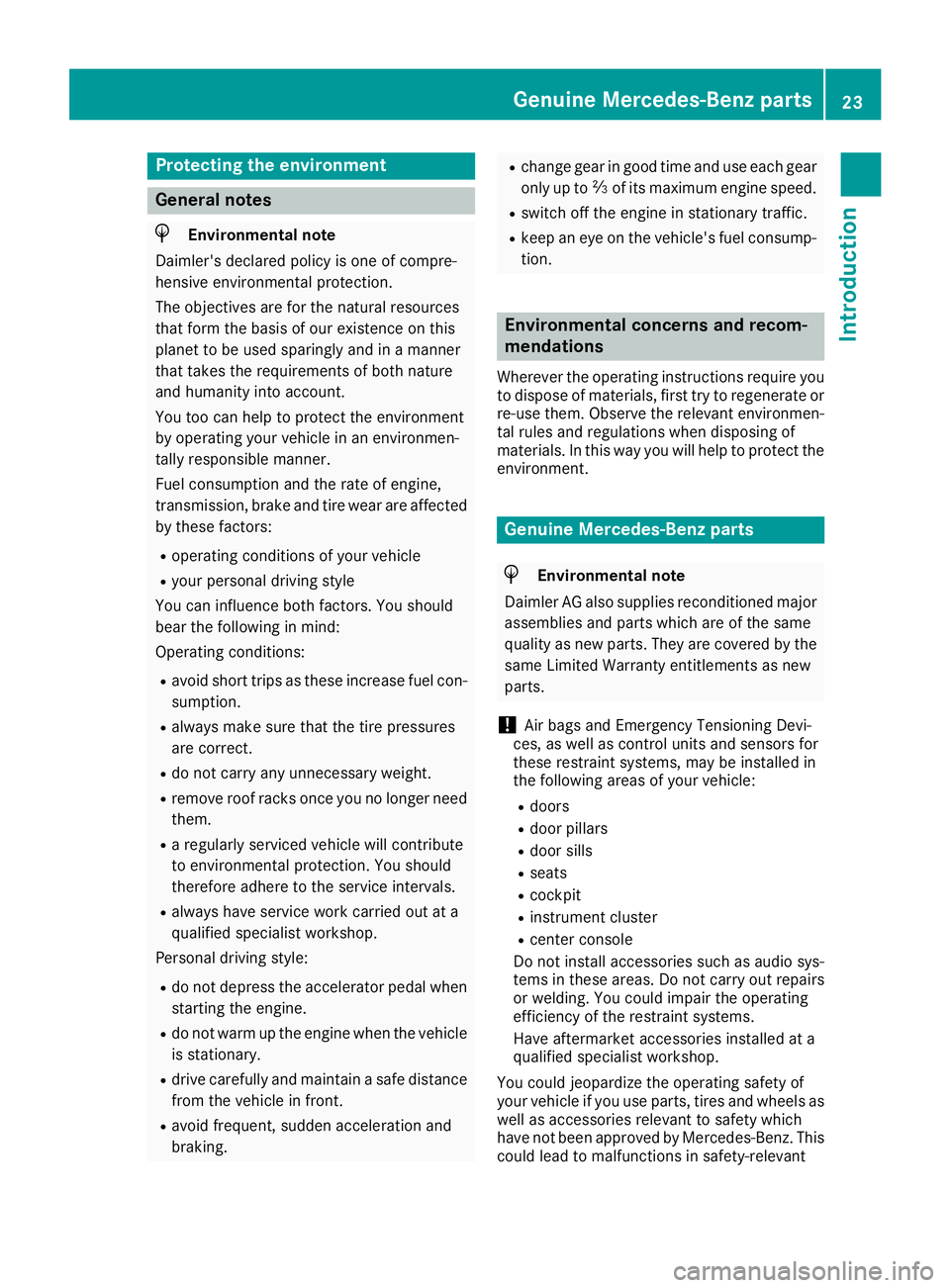
Protecting the environment
General notes
HEnvironmental note
Daimler's declared policy is one of compre-
hensive environmental protection.
The objectives are for the natural resources
that form the basis of our existence on this
planet to be used sparingly and in amanner
that takes the requirements of both nature
and humanity into account.
You too can help to protect the environment
by operating your vehicle in an environmen-
tally responsible manner.
Fuel consumption and the rate of engine,
transmission, brake and tire wear are affected by these factors:
Roperating conditionsofy our vehicle
Ryour personal driving style
You can influence both factors. You should
bear the following in mind:
Operating conditions:
Ravoid short trips as these increase fuel con-
sumption.
Ralways make sure that the tire pressures
are correct.
Rdo not carry any unnecessary weight.
Rremove roof racks once you no longer need
them.
Rar egularly serviced vehicle will contribute
to environmental protection. You should
therefore adhere to the service intervals.
Ralways have service work carried out at a
qualified specialist workshop.
Personal driving style:
Rdo not depress the accelerator pedal when
startin gthe engine.
Rdo not warm up the engine when the vehicle
is stationary.
Rdrive carefully and maintain asafe distance
from the vehicle in front.
Ravoid frequent, sudden acceleration and
braking.
Rchange gear in good time and use each gear
only up to Ôof its maximum engine speed.
Rswitch off the engine in stationary traffic.
Rkeep an eye on the vehicle's fuel consump-
tion.
Environmental concerns and recom-
mendations
Wherever the operating instructions require you
to dispose of materials, first try to regenerate or
re-use them. Observe the relevant environmen-
tal rules and regulations when disposing of
materials. In this way you will help to protect the
environment.
Genuine Mercedes-Benz parts
HEnvironmental note
Daimler AG also suppliesr econditioned major
assemblies and parts which are of the same
quality as new parts. They are covered by the
same Limited Warranty entitlements as new
parts.
!Air bags and Emergency Tensioning Devi-
ces, as well as control units and sensors for
these restraint systems, may be installed in
the following areas of your vehicle:
Rdoors
Rdoor pillars
Rdoor sills
Rseats
Rcockpit
Rinstrumentc luster
Rcenter console
Do not install accessories such as audio sys-
tems in these areas. Do not carry out repairs or welding. You could impair the operating
efficiency of the restraint systems.
Have aftermarket accessories installed at a
qualified specialist workshop.
You could jeopardize the operating safety of
your vehicle if you use parts, tires and wheels as
well as accessories relevant to safety which
have not been approved by Mercedes-Benz. This
could lead to malfunction sinsafety-relevant
Genuine Mercedes-Benz parts23
Introduction
Z
Page 39 of 298
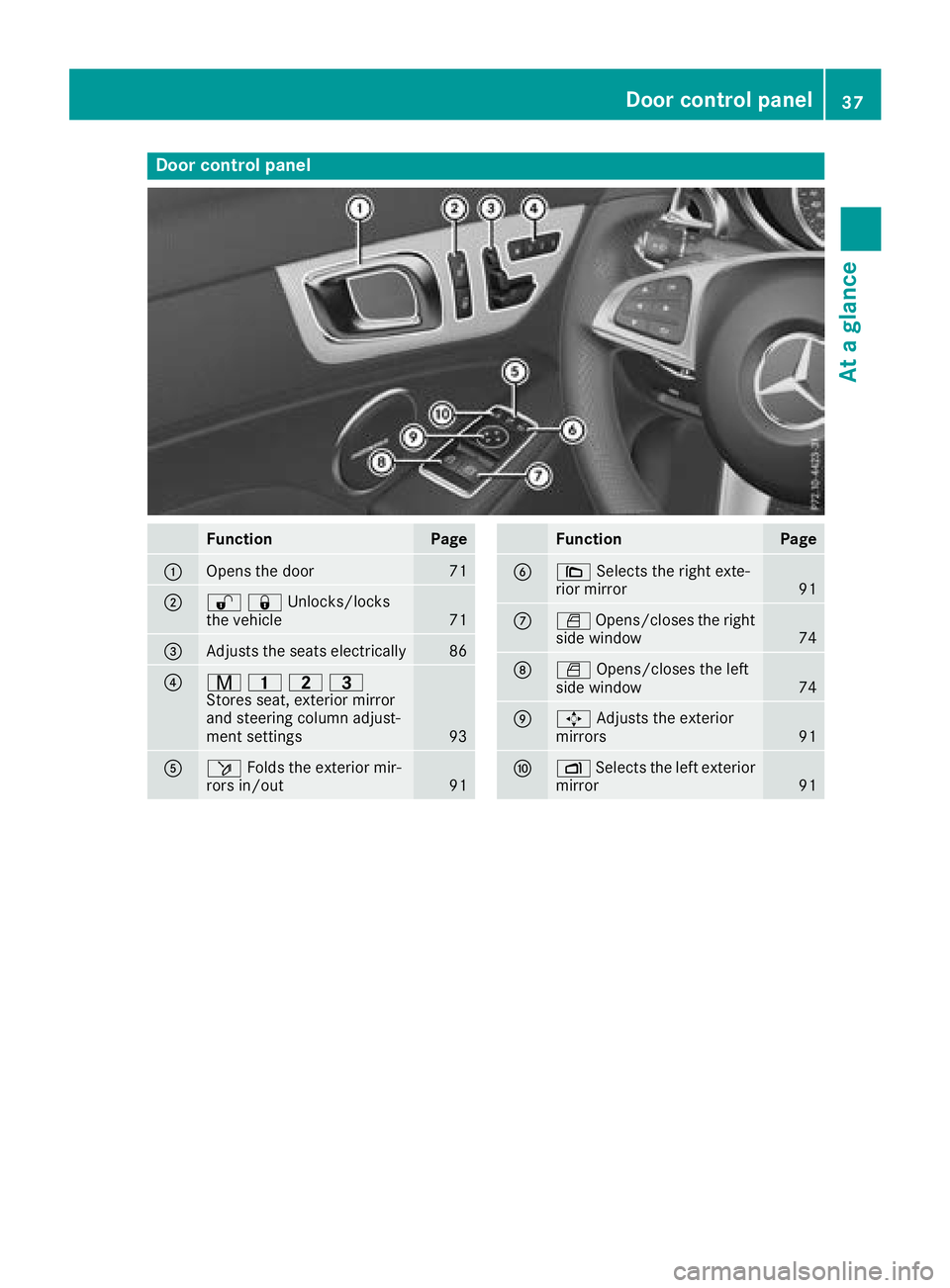
Door controlpanel
FunctionPage
:Opens th edoor71
;%&Unlocks/locks
the vehicle71
=Adjusts the seats electrically86
?r 45=
Stores seat, exterior mirror
and steering column adjust-
ment settings
93
Aö Folds the exterior mir-
rors in/out91
FunctionPage
B\ Selects the right exte-
rio rm irror91
CW Opens/closes the right
sid ew indow74
DW Opens/closes the left
sid ew indow74
E7 Adjusts the exterior
mirrors91
FZ Selects the left exterior
mirror91
Door control panel37
At ag lance
Page 45 of 298
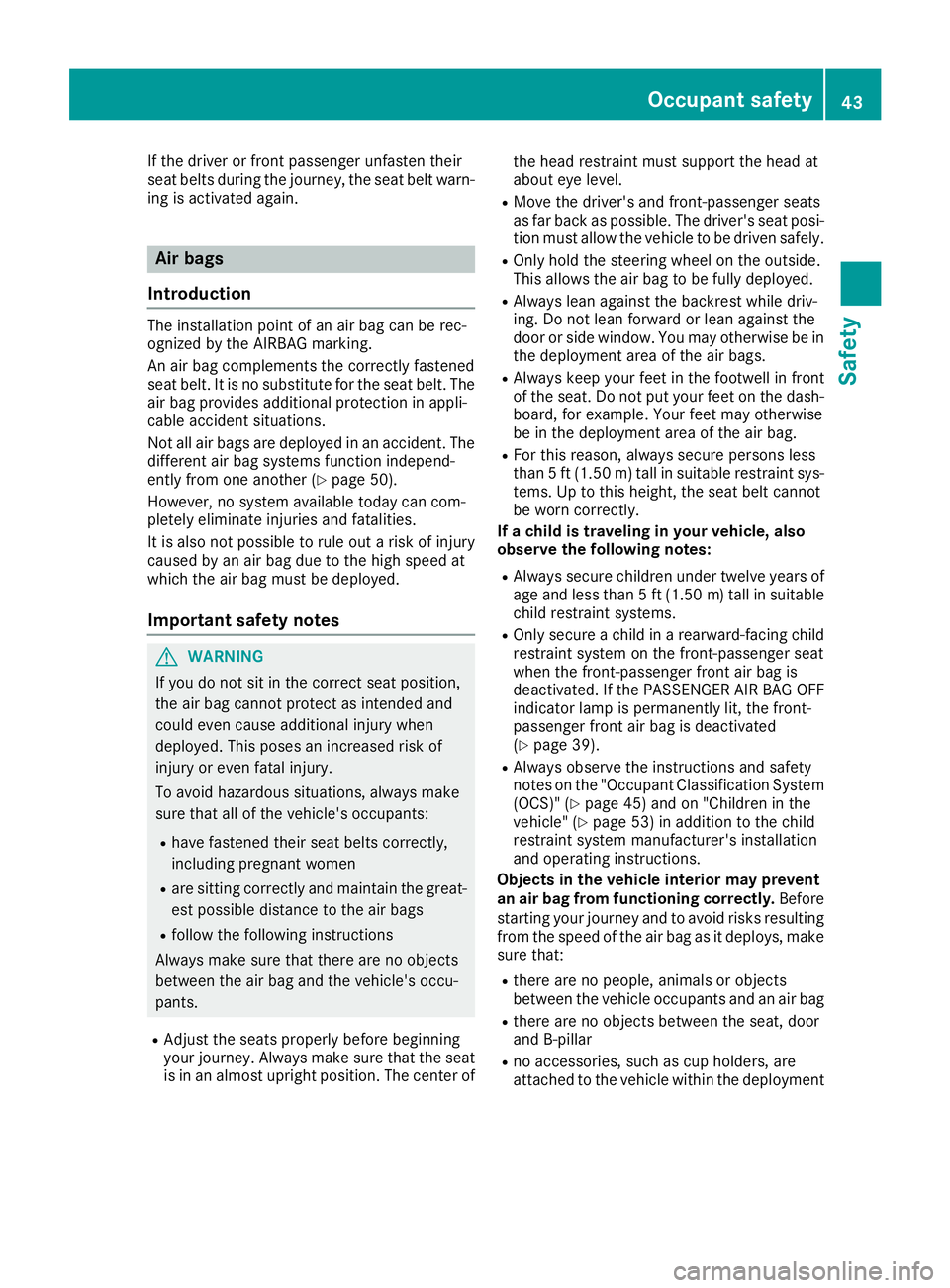
If the driver or front passenger unfasten their
seat belts during the journey, the seat belt warn-
ing is activated again.
Air bags
Introduction
The installation point of an air bag can be rec-
ognized by the AIRBAG marking.
An air bag complements the correctly fastened
seat belt. It is no substitute for the seat belt. The
air bag providesa dditional protection in appli-
cable accident situations.
Not all air bags are deployed in an accident. The
different air bag systems function independ-
ently from one another (
Ypage 50).
However, no system available today can com-
pletelye liminate injuries and fatalities.
It is also not possible to rule out arisk of injury
cause dbyana ir bag due to the high speed at
which the air bag must be deployed.
Important safety notes
GWARNING
If you do not sit in the correct seat position,
the air bag cannot protect as intended and
could even cause additional injury when
deployed .This poses an increased risk of
injury or even fatal injury.
To avoid hazardous situations, always make
sure that all of the vehicle's occupants:
Rhave fastened their seat belts correctly,
including pregnant women
Rare sitting correctly and maintain the great-
est possible distance to the air bags
Rfollow the following instructions
Alway smake sure that there are no objects
between the air bag and the vehicle's occu-
pants.
RAdjust the seats properlyb efore beginning
you rjourney. Alway smake sure that the seat
is in an almostu pright position. The center of the head restraint must support the head at
aboute
ye level.
RMove the driver's and front-passenger seats
as far back as possible. The driver's seat posi-
tion must allow the vehicle to be driven safely.
ROnly hold the steering wheel on the outside.
This allows the air bag to be full ydeployed.
RAlway sleana gainst the backrest whiled riv-
ing. Do not leanf orward or leanagainst the
door or side window.Y ou may otherwise be in
the deployment area of the air bags.
RAlway skeep you rfeet in the footwell in front
of the seat. Do not put you rfeet on the dash-
board,f or example.Y our feet may otherwise
be in the deployment area of the air bag.
RFor this reason, always secure persons less
than 5ft(1.5 0m )tall in suitable restraint sys-
tems. Up to this height, the seat belt cannot
be worn correctly.
If ac hildist raveling in your vehicle, also
observe the following notes:
RAlway ssecure childrenu nder twelve years of
age and less than 5ft(1.50 m)tallins uitable
child restraint systems.
ROnlys ecureac hild in arearward-facing child
restraint systemo nthe front-passenge rseat
when the front-passenge rfront ai rbag is
deactivated .Ifthe PASSENGER AIR BAG OFF
indicator lamp is permanentl ylit,t he front-
passenge rfront ai rbag is deactivated
(
Ypage 39).
RAlway sobser ve the instructions and safety
note sont he "Occupant Classification System
(OCS) "(
Ypage 45) and on "Children in the
vehicle" (Ypage 53 )ina ddit iontot he child
restraint systemm anufacturer's installation
and operating instructions.
Objects in the vehicle interior may prevent
an air bag fromf unctioningcorrectly. Before
startin gyourjourney and to avoi drisks resulting
fromt he spee dofthe airbag as it deploys, make
sure that:
Rthere ar enopeople, animals or objects
between the vehicl eoccupants and an ai rbag
Rthere ar enoobjects between the seat, door
and B-pillar
Rno accessories, such as cup holders, are
attache dtothe vehicl ewithint he deployment
Occupant safety43
Safety
Z
Page 46 of 298
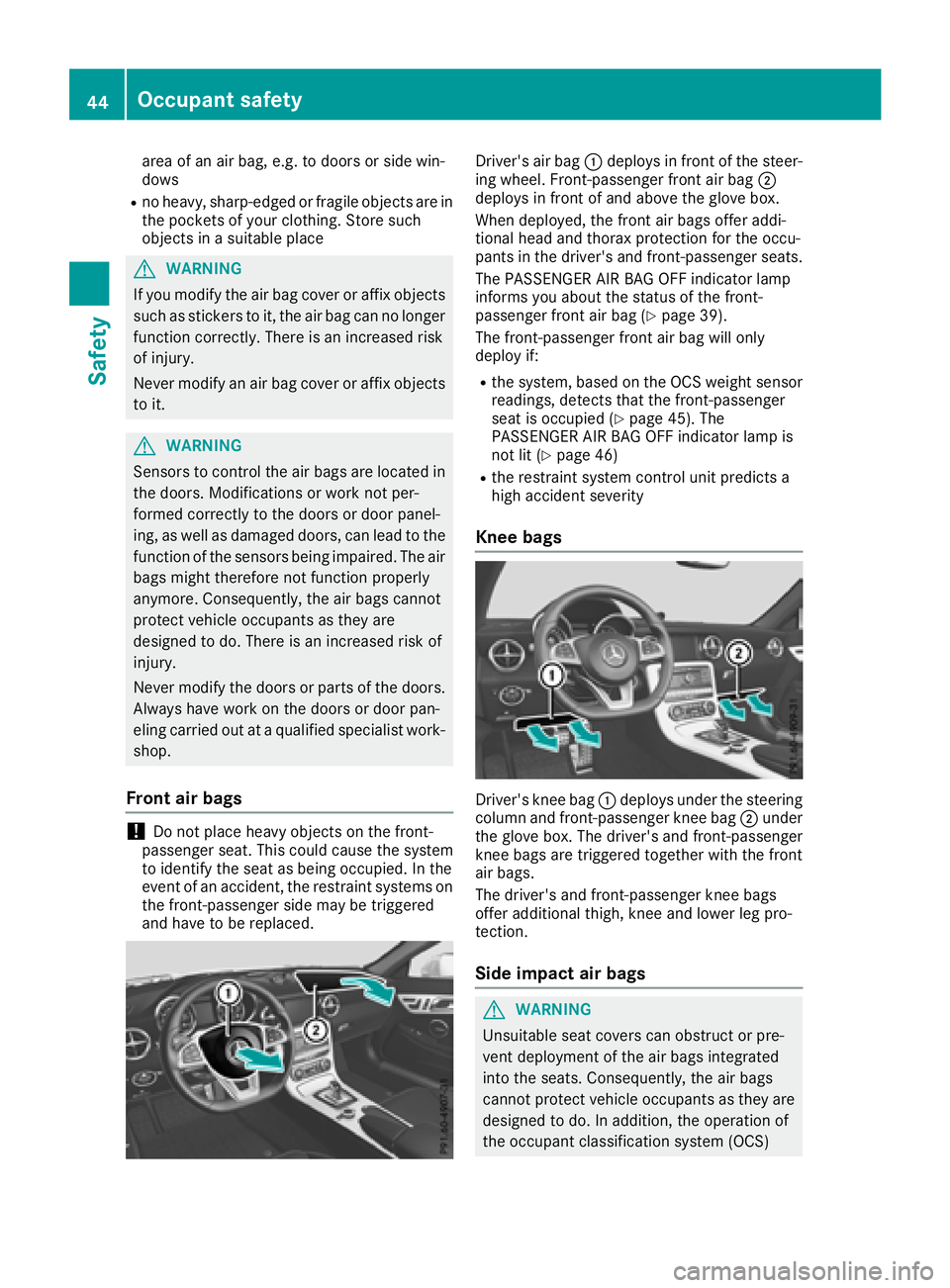
area of an air bag, e.g.todoorsors ide win-
dows
Rno heavy, sharp-edged or fragile object sare in
th ep ockets of your clothing .Store such
object sinas uitable place
GWARNING
If you modify th eair bag cover or affix objects
suchass tickers to it, th eair bag can no longer
function correctly. Thereisani ncreased risk
of injury.
Never modify an air bag cover or affix objects
to it.
GWARNING
Sensorstoc ontrol theair bags are locate din
th ed oors. Modificationsorw ork notper-
formed correctly to th edoorsord oor panel-
ing ,asw ell as damage ddoors, can lead to the
function of th esensorsb eingimpaired. The air
bags mightt herefore no tfunction properly
anymore .Consequently, th eair bags cannot
protect vehicle occupant sastheya re
designed to do. Thereisani ncreased risk of
injury.
Never modify th edoorsorp artsoft hedoors.
Always have work on th edoorsord oor pan-
elingc arried out at aqualified specialist work-
shop.
Fron tair bags
!Do no tplace heavyo bjectsont hefront-
passenger seat.T his couldcaus ethe system
to identif ythe seat as beingo ccupied. In the
eventofana ccident, therestraint systems on
th ef ront-pa ssenger side may be triggered
and have to be replaced.
Driver's air bag :deploys in frontoft hesteer-
ing wheel. Front-passenger fronta ir bag;
deploys in frontofa nd abovethegloveb ox.
When deployed, th efront air bags offer addi-
tional head and thorax protection for th eoccu-
pant sint hedriver'sa nd front-passenger seats.
The PASSENGER AI RBAG OFFi ndicator lamp
inform syou about th estatus of th efront -
passenger fronta ir bag (
Ypage 39).
The front-passenger fronta ir bag will only
deployi f:
Rthes ystem, based on th eOCS weights ensor
readings, detect sthatthe front-passenger
seat is occupied (
Ypage 45). The
PASSENGER AI RBAG OFFi ndicator lamp is
no tlit (
Ypage 46)
Rth er estraint system control unit predict sa
high accidents everity
Knee bags
Driver's knee bag :deploys unde rthe steering
column and front-passenger knee bag ;under
th eg loveb ox.The driver'sa nd front-passenger
knee bags are triggered together with th efront
air bags.
The driver'sa nd front-passenger knee bags
offer additional thigh, knee and lower leg pro-
tection.
Sidei mpact air bags
GWARNING
Unsuitable seat covers can obstruc torpre-
ven tdeploymen toftheair bags integrated
int ot he seats. Consequently, th eair bags
canno tprotect vehicle occupant sastheya re
designed to do. In addition,t heoperatio nof
th eo ccupant classification system (OCS)
44Occupant safety
Safety
Page 54 of 298
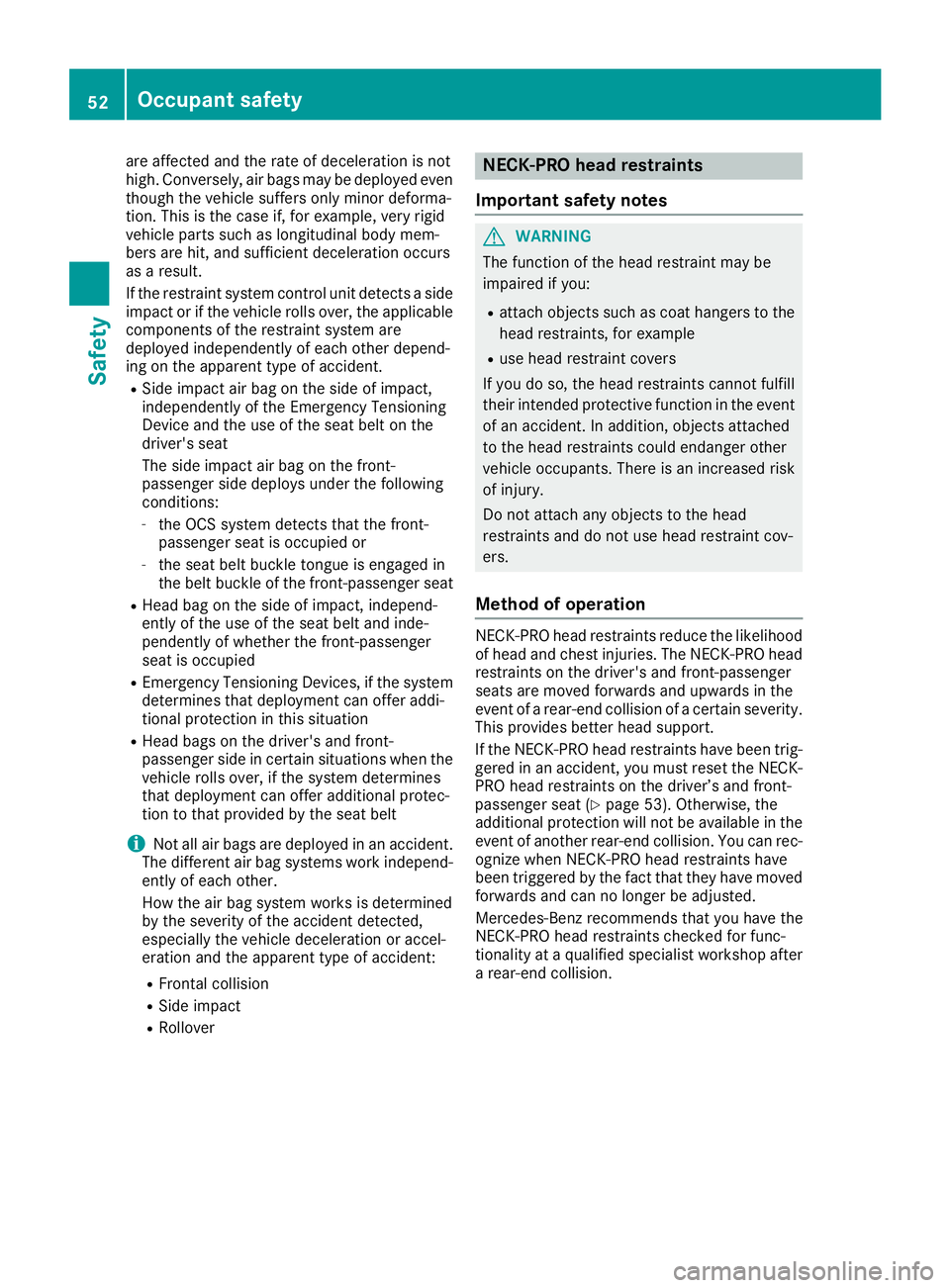
are affected and therateofd eceleratio nisnot
high.C onversely, air bags may be deployed even
though th evehicle suffers only minor deforma-
tion. This is th ecasei f, for example, ver yrigid
vehicle part ssuchasl ongitudinal body mem-
bers are hit,a nd sufficient deceleratio noccurs
as aresult.
If th erestraint system control unit detect saside
impac torift hevehicle roll sover, th eapplicable
component softherestraint system are
deployed independently of each other depend-
ing on th eapparent type of accident.
RSid eimpacta ir bag on th eside of impact,
independently of th eEme rgenc yTensioning
Devic eand th euse of th eseat belt on the
driver'ss eat
The side impac tair bag on th efront -
passenger side deploys unde rthe following
conditions:
-th eO CS system detect sthatthe front-
passenger seat is occupied or
-th es eat belt buckle tongue is engaged in
th eb elt buckle of th efront-pa ssenger seat
RHead bag on th eside of impact, independ-
ently of th euse of th eseat belt and inde-
pendently of whether th efront-pa ssenger
seat is occupied
REmergenc yTensioning Devices, if th esystem
determine sthatd eploymen tcan offer addi-
tional protection in this situation
RHead bags on th edriver'sa nd front-
passenger side in certain situations when the
vehicle roll sover, if t
h
esystem determines
that deploymen tcan offer additional protec-
tio ntot hatp rovided by th eseat belt
iNot all air bags are deployed in an accident.
The differenta ir bag systems work independ-
ently of each other.
How th eair bag system worksisd etermined
by th eseverityoft heaccidentd etected,
especially th evehicle deceleratio noraccel-
eration and th eapparent type of accident:
RFrontal collision
RSid eimpact
RRollover
NECK-PROh eadr estraints
Important safety notes
GWARNING
The function of th ehead restraint may be
impaired if you:
Rattach object ssuchasc oat hangerstot he
head restraints, for example
Ruse head restraint covers
If you do so, th ehead restraint scanno tfulfill
their intended protective function in th eevent
of an accident. In addition,o bjectsattached
to th ehead restraint scoul de ndanger other
vehicle occupants. Thereisani ncreased risk
of injury.
Do no tattach any object stothehead
restraint sand do no tuse head restraint cov-
ers.
Method of operation
NECK-PRO head restraint sreduc ethe likelihood
of head and chest injuries.T he NECK-PRO head
restraint sonthedriver'sa nd front-passenger
seatsa re moved forwards and upwards in the
eventofar ear-endcollision of acertain severity.
This provides bette rhead support.
If th eNECK-PRO head restraint shave been trig-
gered in an accident, you must reset th eNECK-
PRO head restraint sonthedriver’s and front-
passenger seat (
Ypage 53) .Otherwise, the
additional protection will no tbeavailabl einthe
eventofa nother rear-en dcollision.Y ou can rec-
ognize when NECK-PRO head restraint shave
been triggered by th efacttha tthe yh ave moved
forwards and can no longer be adjusted.
Mercedes-Ben zrecommend sthaty ou have the
NECK-PRO head restraint schecked for func-
tionalit yataq ualified specialist workshop after
ar ear-en dcollision.
52Occupant safety
Safety
Page 55 of 298
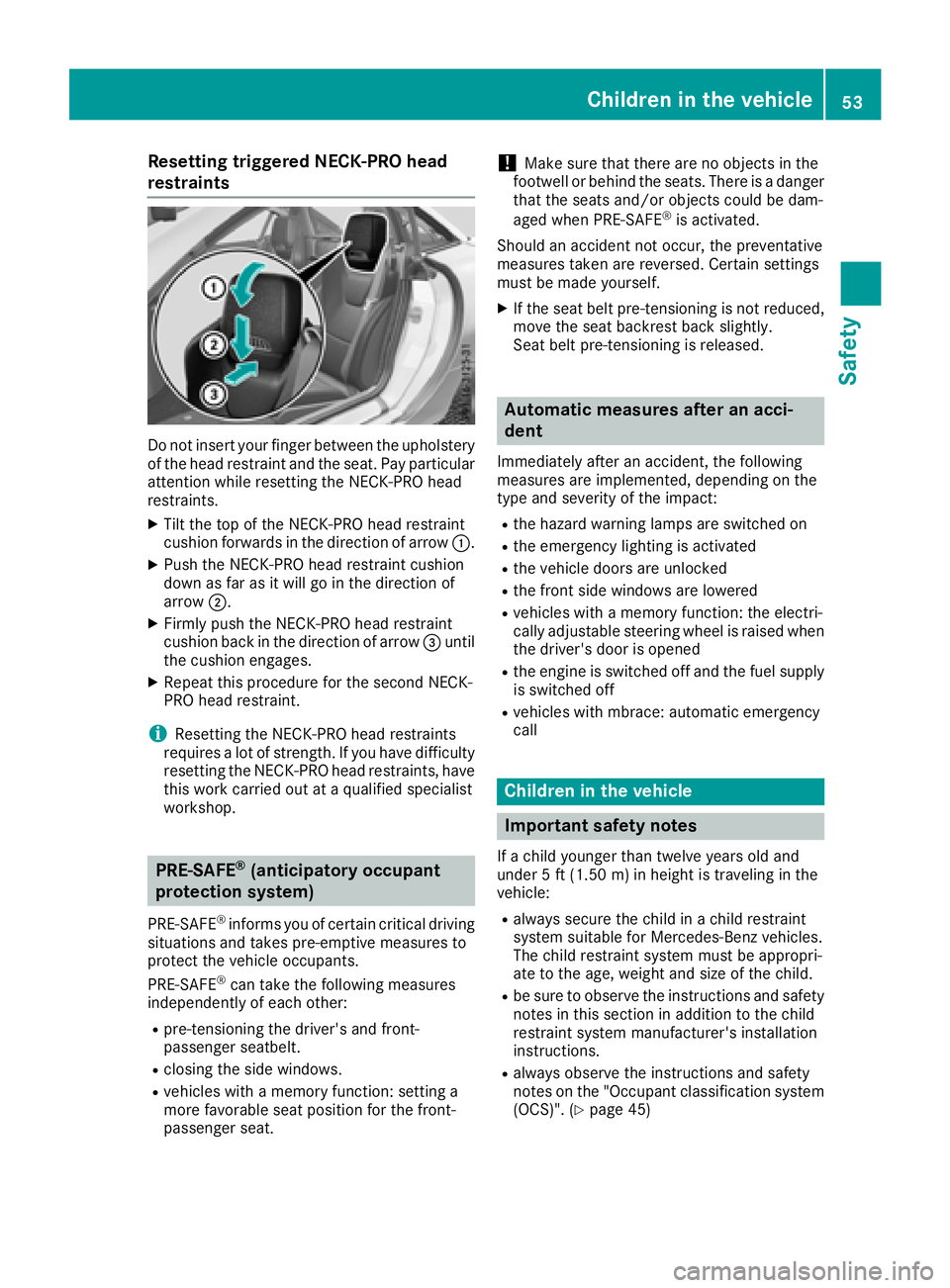
Resetting triggeredNECK-PRO head
restraints
Do not insert your finger between the upholstery of the headr estraint and the seat. Payp articular
attention whil eresetting the NECK-PROh ead
restraints.
XTilt the top of the NECK-PROh eadrestraint
cushio nforward sinthe direction of arrow :.
XPush the NECK-PROh eadrestraint cushion
dow nasfar as it will go in the direction of
arrow ;.
XFirmly push the NECK-PROh eadrestraint
cushio nbackint he direction of arrow =until
the cushio nengages.
XRepea tthis procedure for the second NECK-
PROh eadrestraint.
iResetting the NECK-PROh eadrestraints
requires alot of strength. If yo uhaved ifficulty
resetting the NECK-PROh eadrestraints, have
this work carrie doutataq uali fied specialist
workshop.
PRE-SAFE®(anticipatory occupant
protection system)
PRE-SAFE®informs yo uofcertain critical driving
situations and take spre-emptive measures to
protect the vehicl eoccupants.
PRE-SAFE
®can take the following measures
independentl yofeacho ther:
Rpre-tensioning the driver'sa nd front-
passenger seatbelt.
Rclosing the sid ewindows.
Rvehicles with amemory function: setting a
more favorabl eseatp osition for the front-
passenger seat.
!Make sure that there are no objects in the
footwell or behind the seats. There is adanger
that the seats and/or objects could be dam-
aged when PRE-SAFE
®is activated.
Should an accident not occur, the preventative
measures take nare reversed. Certai nsettings
mus tbem adey ourself.
XIf the seatb eltp re-tensioning is not reduced,
move the seatb ackrest back slightly.
Seatb eltp re-tensioning is released.
Automatic measures after an acci-
dent
Immediately afte ranaccident, the following
measures are implemented, depending on the
typ eand severity of the impact:
Rthe hazard warning lamps are switched on
Rthe emergency lighting is activated
Rthe vehicl edoors are unlocked
Rthe front sid ewindow sare lowered
Rvehicles with amemory function: the electri-
cally adjustabl esteering wheel is raised when
the driver'sd ooriso pened
Rthe engine is switched off and the fue lsuppl y
is switched off
Rvehicles with mbrace: automatic emergency
call
Childrenint he vehicle
Important safety notes
Ifac hild younger than twelve years olda nd
under 5ft(1.50 m) in height is traveling in the
vehicle:
Ralways secur ethe child in achild restraint
systems uitabl efor Mercedes-Benz vehicles.
The child restraint systemm ustbea ppropri-
ate to the age, weight and size of the child.
Rbe sure to observe the instructions and safety
notesint hissectio nina dditiontot he child
restraint systemm anufacturer's installation
instructions.
Ralways observe the instructions and safety
notesont he "Occupant classification system
(OCS)". (
Ypage 45)
Children in the vehicle53
Safety
Z
Page 86 of 298
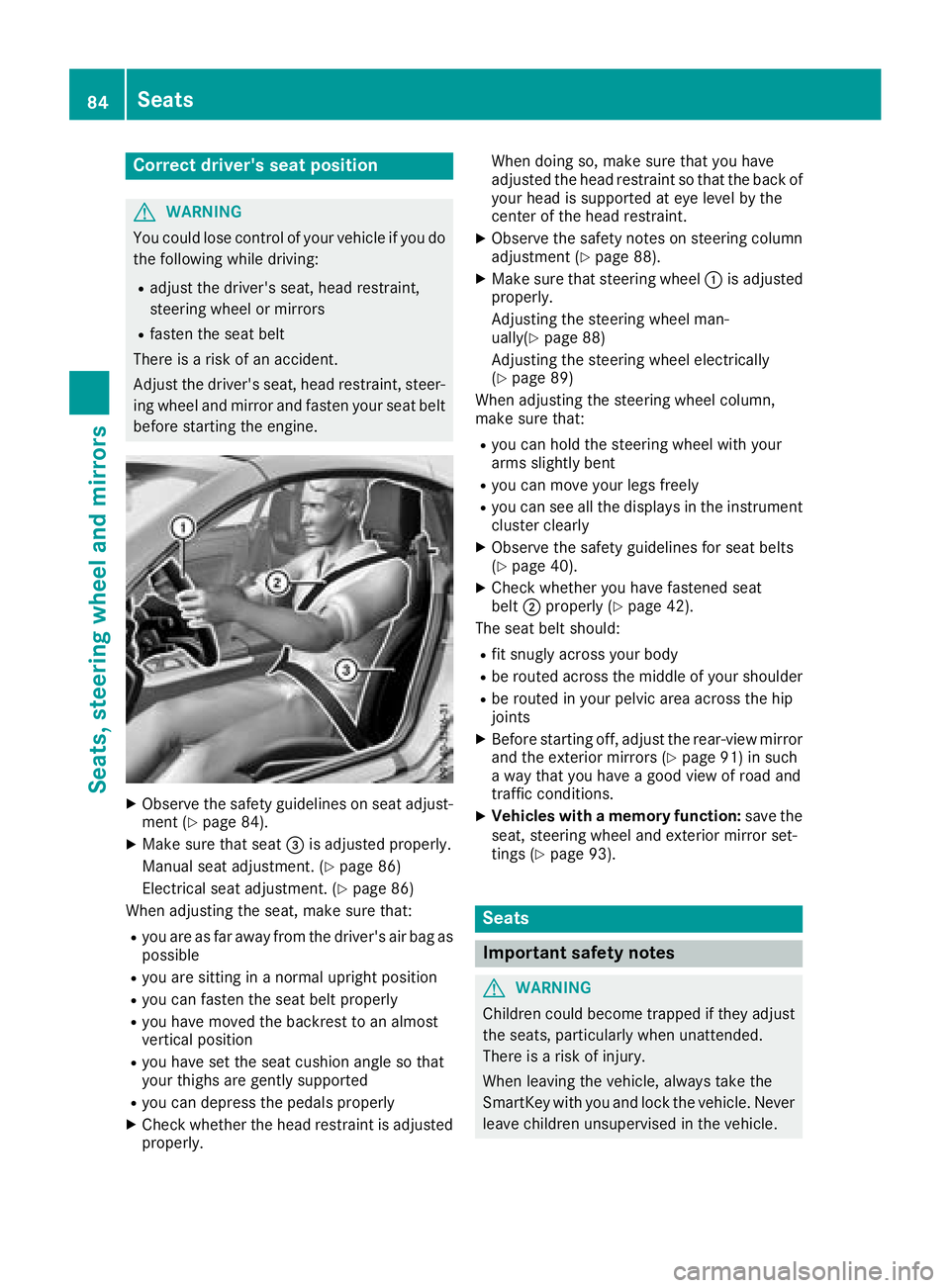
Correct driver's seat position
GWARNING
You coul dlose control of your vehicle if you do
th ef ollowingw hile driving:
Radjust thedriver'ss eat,head restraint,
steering wheel or mirrors
Rfasten th eseat belt
Thereisar iskofana ccident.
Adjust th edriver'ss eat,head restraint ,steer-
ing wheel and mirror and fasten your seat belt before starting th eengine.
XObserv ethe safety guideline sonseat adjust-
men t(Ypage 84).
XMakes ure that seat =is adjusted properly.
Manual seat adjustment. (
Ypage 86)
Electrical seat adjustment. (
Ypage 86)
When adjusting th eseat,m akes ure that:
Ryou are as far away from th edriver'sa ir bag as
possible
Ryou are sittin ginanormalupright position
Ryou can fasten th eseat belt properly
Ryou have moved th ebackres ttoana lmost
vertical position
Ryou have set th eseat cushion angle so that
your thighs are gently supported
Ryou can depress th epedals properly
XCheckw hether th ehead restraint is adjusted
properly. When doings
o, makesure that you have
adjusted th ehead restraint so that th eback of
your head is supported at eye leve lbythe
cente rofthehead restraint.
XObserv ethe safety note sonsteering column
adjustmen t(Ypage 88).
XMakesure that steering wheel :is adjusted
properly.
Adjusting th esteering wheel man-
ually(
Ypage 88)
Adjustin gthe steering wheel electrically
(
Ypage 89)
When adjusting th esteering wheel column,
mak esure that:
Ryou can hold th esteering wheel withy our
arm sslightly bent
Ryou can mov eyour legs freely
Ryou can see all th edisplays in th einstrument
cluste rclearly
XObserv ethe safety guideline sfor seat belts
(Ypage 40).
XCheckw hether you have fastened seat
belt ;properl y(Ypage 42).
The seat belt should:
Rfit snugly across your body
Rbe routed across th emiddle of your shoulder
Rbe routed in your pelvic area across th ehip
joints
XBefore starting off ,adjust th erear-view mirror
and th eexteri or mirror s(Ypage 91) in such
aw ay that you have agood view of road and
traffic conditions.
XVehicles with amemory function: save the
seat,s teering wheel and exterior mirror set-
tings (
Ypage 93).
Seats
Important safety notes
GWARNING
Children coul dbecome trapped if they adjust
th es eats, particularly when unattended.
Thereisar iskofi njury.
When leaving th evehicle ,always tak ethe
SmartKey withy ou and lockthevehicle .Never
leave childre nunsupervised in th evehicle.
84Seats
Seats, steerin gwheel and mirrors
Page 87 of 298
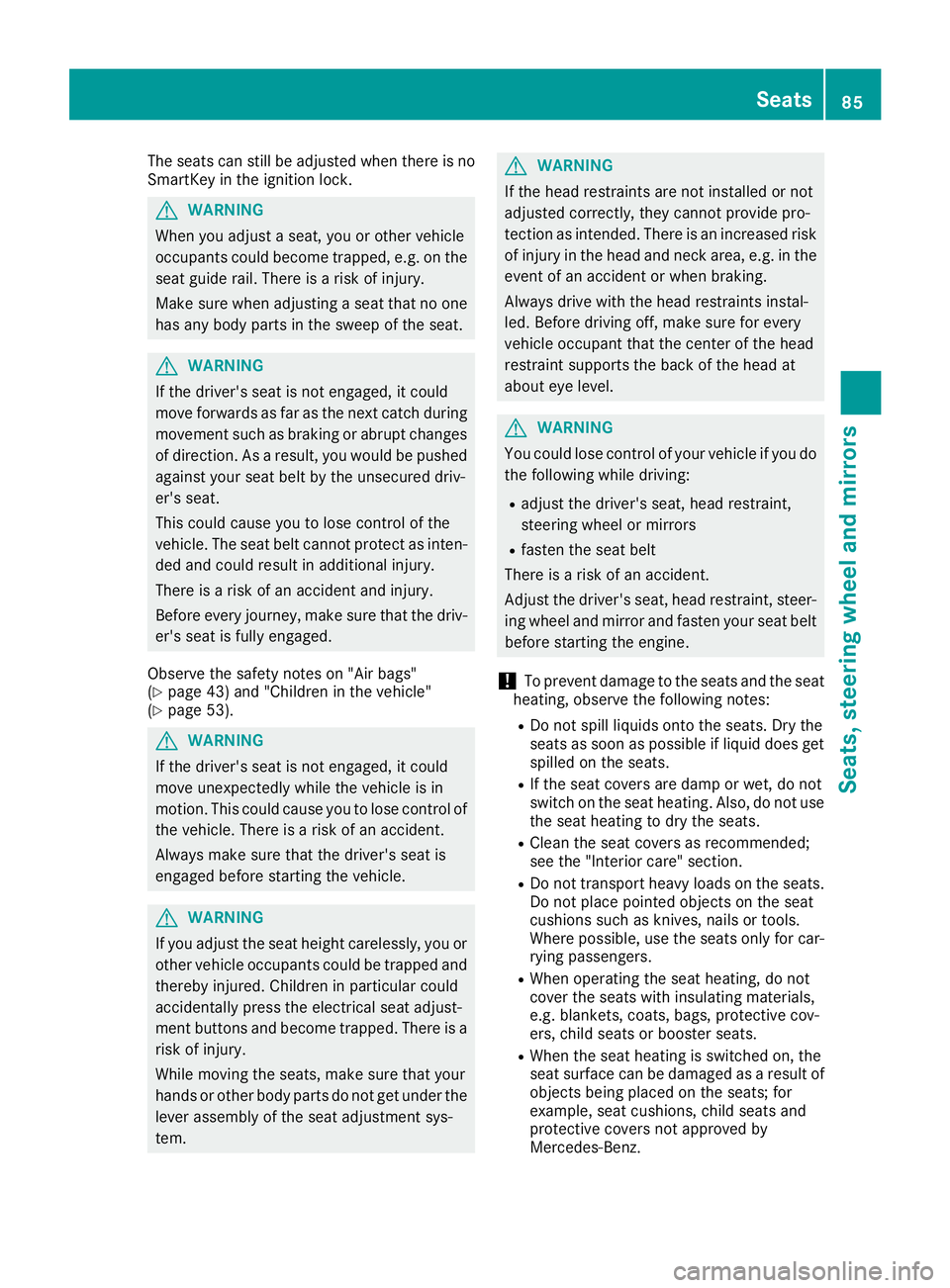
The seats can still be adjusted when there is no
SmartKey in the ignition lock.
GWARNING
When you adjust aseat, you or other vehicle
occupantsc ould become trapped, e.g. on the
seat guide rail. There is arisk of injury.
Make sure when adjusting aseat that no one
has any body parts in the sweep of the seat.
GWARNING
If the driver's seat is not engaged, it could
move forwards as far as the next catc hduring
movements uch as braking or abrupt changes
of direction .Asaresult, you would be pushed
against your seat belt by the unsecured driv-
er's seat.
This could cause you to lose control of the
vehicle. The seat belt cannot protec tasinten-
ded and could result in additional injury.
There is arisk of an accident and injury.
Before every journey, make sure that the driv-
er's seat is fully engaged.
Observe the safety notes on "Air bags"
(
Ypage 43) and "Children in the vehicle"
(Ypage 53).
GWARNING
If the driver's seat is not engaged, it could
move unexpectedly while the vehicle is in
motion.T his could cause you to lose control of
the vehicle. There is arisk of an accident.
Always make sure that the driver's seat is
engaged before starting the vehicle.
GWARNING
If you adjust the seat height carelessly, you or
other vehicle occupantsc ould be trapped and
thereby injured. Children in particular could
accidentally press the electrical seat adjust-
ment button sand become trapped. There is a
risk of injury.
While moving the seats, make sure that your
hands or other body parts do not get under the
lever assembly of the seat adjustmen tsys-
tem.
GWARNING
If the head restraints are not installed or not
adjusted correctly, they cannot provide pro-
tection as intended. There is an increased risk
of injury in the head and neck area, e.g. in the event of an accident or when braking.
Always drive with the head restraints instal-
led. Before driving off, make sure for every
vehicle occupant that the center of the head
restraint supports the back of the head at
about eye level.
GWARNING
You could lose control of your vehicle if you do the following while driving:
Radjust the driver's seat, head restraint,
steerin gwheel or mirrors
Rfasten the seat belt
There is arisk of an accident.
Adjust the driver's seat, head restraint, steer-
ing wheel and mirror and fasten your seat belt before starting the engine.
!To prevent damage to the seats and the seat
heating, observe the following notes:
RDo not spill liquids ontot he seats. Dry the
seats as soon as possible if liquid does get
spilled on the seats.
RIf the seat covers are damp or wet, do not
switch on the seat heating. Also, do not use
the seat heating to dry the seats.
RClean the seat covers as recommended;
see the "Interior care" section.
RDo not transport heavy loads on the seats.
Do not place pointed object sonthe seat
cushions such as knives, nails or tools.
Where possible, use the seats only for car-
rying passengers.
RWhen operating the seat heating, do not
cover the seats with insulating materials,
e.g. blankets ,coats, bags, protective cov-
ers, child seats or booster seats.
RWhen the seat heating is switched on, the
seat surface can be damaged as aresult of
object sbeing placed on the seats; for
example, seat cushions, child seats and
protective covers not approved by
Mercedes-Benz.
Seats85
Seats, steering wheel and mirrors
Z